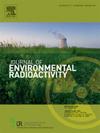多种放射性核素和低活度放射源的伽马射线成像方法。
IF 1.9
3区 环境科学与生态学
Q3 ENVIRONMENTAL SCIENCES
引用次数: 0
摘要
伽玛射线编码孔径成像技术在核安全、隔离源探测和核设施退役等领域有着重要的应用。然而,人工制品会降低重建图像的质量,并影响对放射源强度和位置的识别。本文提出了一种基于原始和反向编码函数(PRCF)的伽马射线编码孔径成像方法,以减少成像伪影。在此基础上,通过整合探测器收集的能谱信息对PRCF方法进行了改进。通过选择不同放射源特征能量对应的能量区间进行数据滤波,进一步增强了PRCF方法对多放射源的成像能力。通过仿真,确定了PRCF方法中校正因子的选取范围。利用自建的基于CdZnTe像元探测器的编码孔径成像系统进行了单源和多源成像实验,建立了不同放射源能量区间范围的选择准则。与传统的最大似然期望最大化(MLEM)方法相比,改进的PRCF方法不仅有效地减少了伪影,提高了成像质量,而且保证了多放射源成像结果的准确性。此外,通过低活度137Cs和高活度241Am和133Ba的成像实验,证明了PRCF方法可以在复杂环境下实现低计数成像,为低活度放射源成像提供了解决方案。本文章由计算机程序翻译,如有差异,请以英文原文为准。
A gamma-ray imaging method for multiple radionuclides and low-activity radioactive sources
Gamma-ray coded-aperture imaging technology has important applications in the fields of nuclear security, isolated source detection, and the decommissioning of nuclear facilities. However, artifacts can reduce the quality of reconstructed images and affect the identification of the intensity and location of radioactive sources. In this paper, a gamma-ray coded-aperture imaging method based on primitive and reversed coded functions (PRCF) was proposed to reduce imaging artifacts. Building on this, the PRCF method was improved by integrating energy spectral information collected by the detector. By selecting energy intervals corresponding to characteristic energies of different radioactive sources for data filtering, the imaging capability of the PRCF method was further enhanced for multiple radioactive sources. Through simulation, the selection range of the correction factor in the PRCF method was determined. Single-source and multi-source imaging experiments were conducted using the self-built coded-aperture imaging system based on a CdZnTe pixel detector, and the selection criteria for the energy interval ranges of different radioactive sources were established. Compared with the conventional maximum likelihood expectation maximization (MLEM) method, the improved PRCF method not only effectively reduced artifacts and enhanced the imaging quality, but also ensured the accuracy of imaging results for multiple radioactive sources. Moreover, through imaging experiments using low-activity 137Cs and high-activity 241Am and 133Ba, it was demonstrated that the PRCF method can achieve low-count imaging in complex environments, providing a solution for imaging low-activity radioactive sources.
求助全文
通过发布文献求助,成功后即可免费获取论文全文。
去求助
来源期刊

Journal of environmental radioactivity
环境科学-环境科学
CiteScore
4.70
自引率
13.00%
发文量
209
审稿时长
73 days
期刊介绍:
The Journal of Environmental Radioactivity provides a coherent international forum for publication of original research or review papers on any aspect of the occurrence of radioactivity in natural systems.
Relevant subject areas range from applications of environmental radionuclides as mechanistic or timescale tracers of natural processes to assessments of the radioecological or radiological effects of ambient radioactivity. Papers deal with naturally occurring nuclides or with those created and released by man through nuclear weapons manufacture and testing, energy production, fuel-cycle technology, etc. Reports on radioactivity in the oceans, sediments, rivers, lakes, groundwaters, soils, atmosphere and all divisions of the biosphere are welcomed, but these should not simply be of a monitoring nature unless the data are particularly innovative.
 求助内容:
求助内容: 应助结果提醒方式:
应助结果提醒方式:


